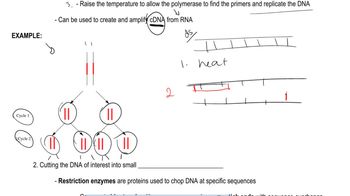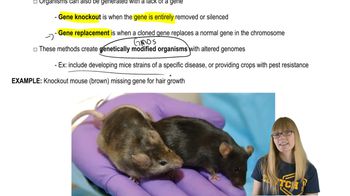Which of the following describes the 3D structure of multiple polypeptide chains in a single protein?
Table of contents
- 1. Introduction to Genetics51m
- 2. Mendel's Laws of Inheritance3h 37m
- 3. Extensions to Mendelian Inheritance2h 41m
- 4. Genetic Mapping and Linkage2h 28m
- 5. Genetics of Bacteria and Viruses1h 21m
- 6. Chromosomal Variation1h 48m
- 7. DNA and Chromosome Structure56m
- 8. DNA Replication1h 10m
- 9. Mitosis and Meiosis1h 34m
- 10. Transcription1h 0m
- 11. Translation58m
- 12. Gene Regulation in Prokaryotes1h 19m
- 13. Gene Regulation in Eukaryotes44m
- 14. Genetic Control of Development44m
- 15. Genomes and Genomics1h 50m
- 16. Transposable Elements47m
- 17. Mutation, Repair, and Recombination1h 6m
- 18. Molecular Genetic Tools19m
- 19. Cancer Genetics29m
- 20. Quantitative Genetics1h 26m
- 21. Population Genetics50m
- 22. Evolutionary Genetics29m
11. Translation
Proteins
Problem B.5
Textbook Question
Describe the gene and protein defects in phenylketonuria (PKU). How are these defects connected to disease symptoms?
 Verified step by step guidance
Verified step by step guidance1
Step 1: Understand that phenylketonuria (PKU) is caused by mutations in the gene encoding the enzyme phenylalanine hydroxylase (PAH), which is responsible for converting the amino acid phenylalanine into tyrosine.
Step 2: Recognize that the gene defect leads to a deficient or nonfunctional PAH enzyme, resulting in an inability to metabolize phenylalanine properly.
Step 3: Explain that the protein defect (nonfunctional or deficient PAH enzyme) causes phenylalanine to accumulate in the blood and tissues, leading to toxic levels.
Step 4: Connect the accumulation of phenylalanine to the disease symptoms, such as intellectual disability, developmental delays, and neurological problems, due to its toxic effects on brain development and function.
Step 5: Summarize that the gene mutation causes a defective enzyme, which disrupts normal metabolism of phenylalanine, and this metabolic block leads directly to the clinical manifestations of PKU.
 Verified video answer for a similar problem:
Verified video answer for a similar problem:This video solution was recommended by our tutors as helpful for the problem above
Video duration:
2mPlay a video:
Was this helpful?
Key Concepts
Here are the essential concepts you must grasp in order to answer the question correctly.
Phenylketonuria (PKU) and its Genetic Basis
PKU is an inherited metabolic disorder caused by mutations in the PAH gene, which encodes the enzyme phenylalanine hydroxylase. This enzyme is responsible for converting phenylalanine to tyrosine. Defects in the PAH gene lead to reduced or absent enzyme activity, causing phenylalanine accumulation.
Recommended video:
Guided course

Genetic Cloning
Role of Phenylalanine Hydroxylase Enzyme
Phenylalanine hydroxylase catalyzes the hydroxylation of phenylalanine to tyrosine, a precursor for neurotransmitters. When this enzyme is defective, phenylalanine builds up to toxic levels, disrupting normal brain development and function, which underlies the neurological symptoms of PKU.
Recommended video:
Connection Between Molecular Defects and Disease Symptoms
The accumulation of phenylalanine and its metabolites in PKU leads to neurotoxicity, causing intellectual disability, seizures, and behavioral problems. The lack of tyrosine also impairs neurotransmitter synthesis, further contributing to cognitive and developmental issues seen in untreated PKU patients.
Recommended video:
Guided course

Transgenic Organisms and Gene Therapy
Related Videos
Related Practice
Multiple Choice
396
views
2
rank



